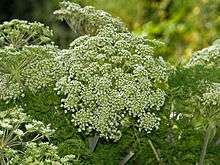Selinum
Selinum is a Eurasiatic genus of flowering plants in the parsley family Apiaceae.[1]
| Selinum | |
|---|---|
 | |
| Selinum tenuifolium at the Orto Botanico di Brera, Milano | |
| Scientific classification | |
| Kingdom: | |
| (unranked): | |
| (unranked): | |
| (unranked): | |
| Order: | |
| Family: | |
| Tribe: | |
| Genus: | Selinum |
Species
The Plant List accepts the following eight species and one variety :
- Selinum capitellatum (A. Gray) Benth. and Hook. f.
- Selinum capitellatum var. scabrum (Jeps.) Munz
- Selinum carvifolia (L.) L. - Cambridge Milk-parsley or Little-leaf Angelica
- Selinum cryptotaenium Boissieu
- Selinum longicalycinum M.L. Sheh
- Selinum papyraceum C.B. Clarke
- Selinum pyrenaeum (L.) Gouan
- Selinum vaginatum C.B. Clarke - Bhoe, Bura, Mutoshal etc.
- Selinum wallichianum (DC.) Raizada & H.O. Saxena syn. Selinum tenuifolium Wall. ex C.B. Clarke - Bhootkeshi, Dhoopkesh etc.[2]
Ornamental use
Selinum wallichianum is a handsome and long-lived, hardy, herbaceous perennial, suitable for woodland gardens and mixed borders.[3]
Folk-medicinal and ritual uses
Several Himalayan species belonging to the genus are both taken internally and burnt as dhoop or incense as sedatives to soothe mental turmoil of various kinds in Tantric rituals. Given that aphrodisiac properties are also reported they may also be used in practices related to sex magic / sacred sexuality. They are aromatic and mildly psychoactive without being unduly toxic - some species are recorded as having been used both as human food and cattle fodder.[4]
References
- Umbellifers of the British Isles B.S.B.I. Handbook No.2. Tutin, T.G. Pub. Botanical Society of the British Isles, London 1980. pps. 152-3.
- .The Plant List (2013). Version 1.1. Published on the Internet; http://www.theplantlist.org/ (accessed 7/10/17)
- The Royal Horticultural Society A-Z Encyclopedia of Garden Plants Editor-in-Chief Christopher Brickell, pub. Dorling Kindersley 1996, reprinted 1997, ISBN 0-7513-0303-8 page 952.
- Quattrocchi, Umberto (2012). CRC World dictionary of medicinal and poisonous plants: common names, scientific names, eponyms, synonyms and etymology. Volume 5 R-Z. CRC Press Taylor and Francis Group, page 228.